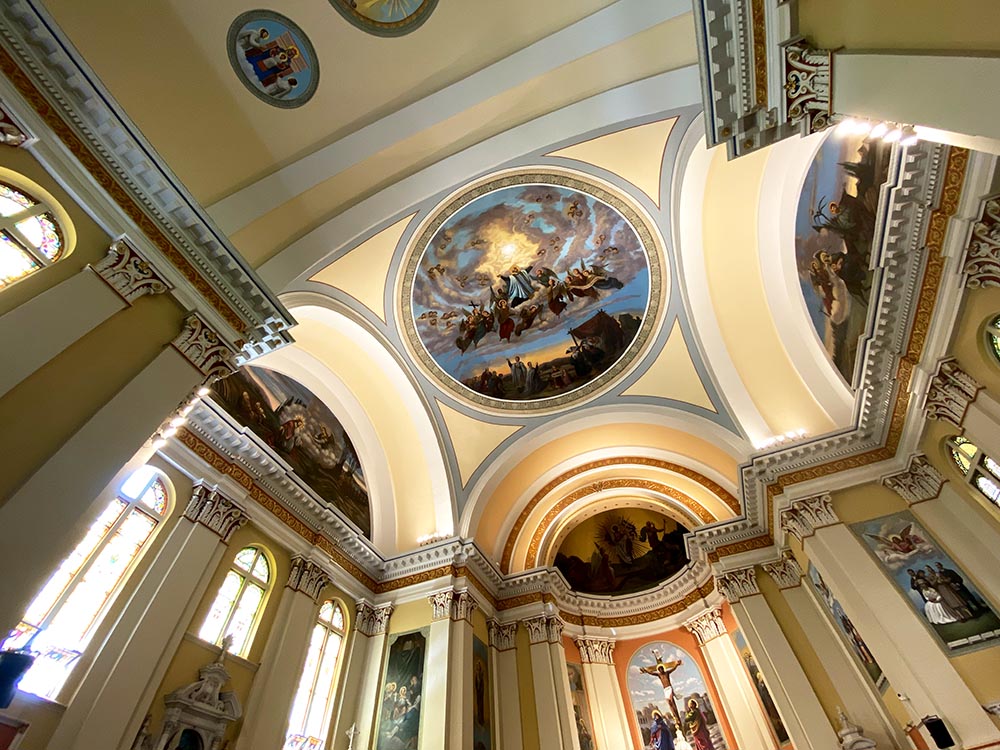The National Fund for Sacred Places, a program of Partners for Sacred Places in collaboration with the National Trust for Historic Preservation, works to help many of America’s most significant congregations advance the care and use of their historic properties. The only program of its kind in the country serving purpose-built houses of worship, the National Fund is more than a grant program. It also provides wraparound services including a $5,000 planning grant, capacity-building training, and tailored technical assistance to support capital project planning and fundraising – all designed to ensure that each congregation is able to reach its fundraising goal and complete a once-in-a-generation capital project.
Now in its sixth year, the National Fund for Sacred Places has streamlined the grant program so that participating congregations can move through the program – and successfully complete their capital projects – in a timely manner. Partners has worked to ensure that incoming congregations are well-positioned to undertake the work they are proposing, and has strengthened its technical assistance for each faith community.
In addition, each congregation that applies to the Fund — over 300 in 2021 alone — is given an opportunity to receive feedback on its readiness for a major project. Partners’ goal is to have an impact on each and every congregation that comes to the Fund for assistance.
We are pleased to announce that the following congregations have completed their projects this year: 16th Street Baptist Church in Birmingham, AL; National City Christian Church in Washington, D.C.; and St. Vincent de Paul Roman Catholic Church in Philadelphia.
16th Street Baptist Church
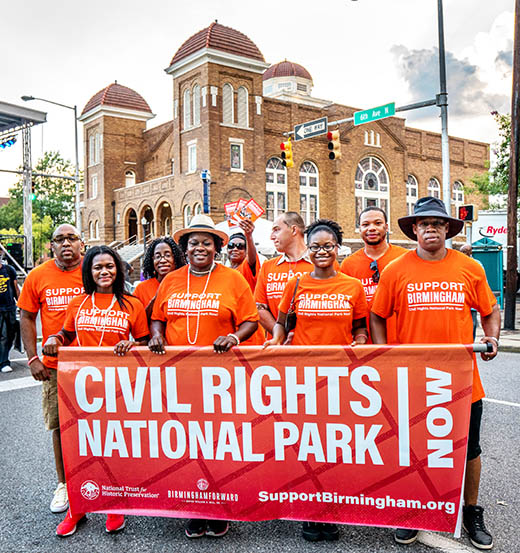
16th Street Baptist Church lobbied for the creation of the Birmingham Civil Rights National Monument, which emcompasses four city blocks and seven sites.
Photo Credit: Mark Sandlin
16th Street Baptist Church is known around the world for what happened on Sunday, September 15, 1963, when members of the Ku Klux Klan planted dynamite under the steps of the church, killing four young girls – Addie Mae Collins, Denise McNair, Carole Robertson, and Cynthia Wesley. 16th Street Baptist was targeted due to its prominent location — just blocks from Birmingham’s City Hall and commercial district — and its close association with the Civil Rights movement. Throughout the 1960s, the church was the site of mass meetings and rallies.
Nearly sixty years later, 16th Street Baptist Church, a National Historic Landmark, is home to a vital, 500-member congregation that is continuing the good work it is known for. It hosts numerous special events each year – from town hall meetings to concerts. In addition, the church also offers outreach ministries focused on supporting new fathers and people in recovery.
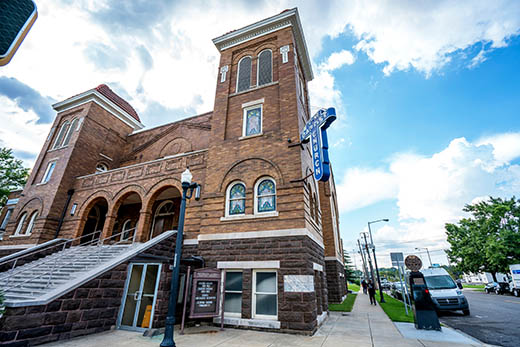
16th Street Baptist Church, which draws tens of thousands of visitors per year, is a member of the Alabama African American Civil Rights Historic Sites Consortium.
Photo Credit: Mark Sandlin
16th Street Baptist Church is also a much-visited site for tourists and visitors. The church provides one-hour tours to visitors from all over the world who are interested in learning about the church’s role in American history, its ongoing commitment to justice and equity, and its identity as a church community. Prior to the COVID-19 pandemic, it welcomed more than 100,000 visitors annually.
When 16th Street Baptist first approached the National Fund in 2017, it had recently completed a $3.5 million restoration of the main church building and was planning to stabilize and rehabilitate its 1911 parsonage. The parsonage will be the future home of the Wallace A. Rayfield Museum, named after an African American architect who studied at Pratt Institute and Columbia University and served as the architect of the parsonage.
The $750,000 scope of work supported by the National Fund will address the entire exterior of the building, including the restoration and repair of the parsonage foundation and exterior (roof, masonry, windows, doors and porch steps), and the creation of an ADA accessible ramp. It also included some interior work: a complete electrical upgrade; restoration and painting of the walls, ceiling, plaster, and wood trim; and a bathroom remodeling. Other grants will support the remaining interior work and the museum planning that lies ahead.
National City Christian Church
National City Christian Church fully embodies the National Fund’s core values. It is dedicated to the stewardship of its remarkable historic building; it is a lively and healthy congregation; it reflects on and actively works to strengthen its role in the community it serves; and it opens its doors to nonmembers who utilize the programs offered by the church as well as the partner nonprofits that use its space.
The Washington, D.C. church is the steward of a historic Neoclassical building designed by John Russell Pope, who later went on to design important Federal civic buildings such as the National Archives (1935), the National Gallery of Art (1941), and Jefferson Memorial (1943). National City’s building was built in 1930, on the eve of the Great Depression, with funds donated by thousands of fellow Disciples of Christ congregations across the nation.
National City’s building houses numerous community-serving programs and partnerships. Through its food pantry, which began 15 years ago, the church provides groceries to up to 275 families each week. Some of the families that participate in this program have access to kitchens and some do not, and the program has adapted to take this into account. The church also hosts midday organ recitals each Friday and a weekday playgroup for toddlers.
National City, which received $250,000 from the National Fund, was admitted into the program in 2019. It’s scope of work included the replacement and upgrading of its heating, ventilation and air conditioning systems, as well as other building systems such as electrical service, hot water and chilled water supply. This work will play an essential role in ensuring that National City remains a vital, community-serving place.
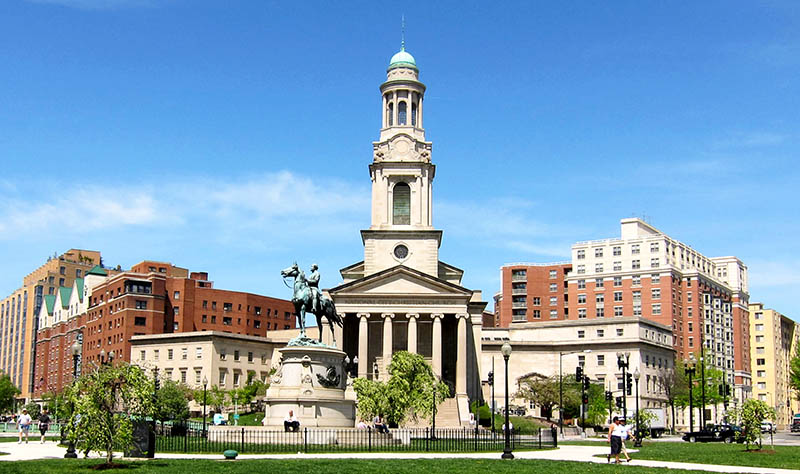
National City Christian Church on Thomas Circle in Washington, D.C.
Photo Credit: Rev. Steven C. Baines
St. Vincent de Paul Roman Catholic Church
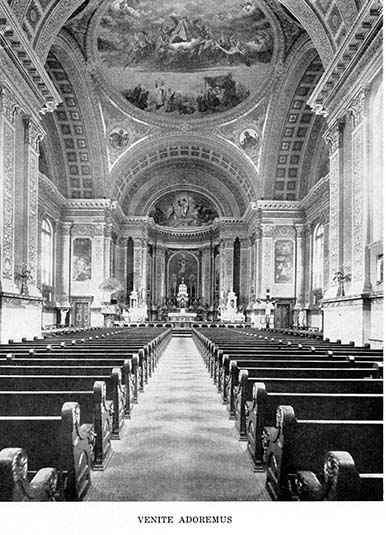
A 1951 photograph of St. Vincent de Paul Roman Catholic Church in Philadelphia.
Courtesy of St. Vincent de Paul Church
The Roman Catholic church of St. Vincent de Paul, located in Philadelphia’s Germantown neighborhood, entered the program in 2019. The Vincentian parish is well known throughout the city for its serene urban property centered upon a historic 1851 church designed by architect Joseph D. Koecke; its diverse and welcoming congregation; and a deep commitment to social justice issues such as racial reconciliation.
Led by Fr. Sylvester Peterka, the church hosts many community-serving nonprofit organizations including: Face to Face, which serves unhoused neighbors by providing food, laundry services, healthcare, legal aid, and educational programming for youth; and My Place Germantown, which is a supportive housing facility for disabled men. In addition, the parish partners with mission-aligned groups, including POWER, New Sanctuary Movement of Philadelphia, Inn-Dwelling, PAR-Recycle Works, and a sister parish in Venezuela.
When St. Vincent de Paul came to the Fund, the parish was contending with a badly damaged sanctuary. Water infiltration caused decorative paint and plaster to delaminate and fail, necessitating the installation of protective netting. Although such netting is not uncommon in historic houses of worship contending with deteriorating plaster ceilings, it can have an effect on church morale over time.
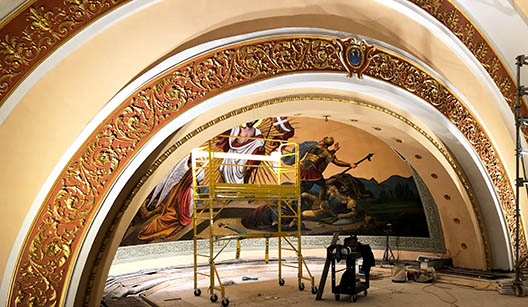
Damaged arches being repaired and restored.
Courtesy of St. Vincent de Paul Church
St. Vincent de Paul was a good fit for the Fund given the significance of its congregation and building; the impact of its programming; its readiness to take on a major capital project, and its history of successful fundraising. The church’s proposed project, with a total cost of $1.2 million, included the repair and restoration of decorative plaster, the stabilization and conservation of deteriorated murals, the creation of new murals that include images of saints and church leaders of color, and wall painting. The Fund’s $250,000 grant helped to pay for scaffolding, plasterwork, and painting.
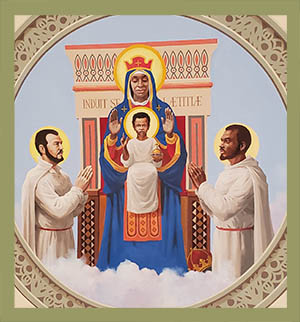
New, more inclusive, artwork was recently unveiled at St. Vincent de Paul.
Rachel Hildebrandt
The work began in September of 2020 and concluded in April of this year, just in time for Holy Week. EverGreene Architectural Arts did the majority of the work and VITETTA Architects & Engineers oversaw the project, serving as a liaison between the parish and the conservators.
Although there is always more work to do, Germantown’s only Catholic parish shines once again – inside and out. Of the role of the National Fund, Fr. Peterka commented: “We could not and would not have done it without your help.”
The 2021 COHORT of the
National Fund for Sacred Places
In October, Partners and National Trust for Historic Preservation welcomed fifteen new congregations into the 2022 cohort of the National Fund for Historic Places. Collectively, these congregations are slated to receive over $2.3 million in grant funding. The congregations are:
- Amana Church Society – Middle Amana, IA
- Arch Street United Methodist Church – Philadelphia, PA
- Calvary United Methodist Church – Philadelphia, PA
- First Christian Church (Nondenominational) – Columbus, IN
- First Indian Presbyterian Church – Kamiah, ID
- First Presbyterian Church – Pittsburgh, PA
- Grace Episcopal Church – Newton Corner, MA
- Let Freedom Ring Foundation/First Baptist Church – Williamsburg, VA
- Mount Zion United Methodist Church – Washington, D.C.
- Sacred Heart Parish (Catholic) – El Paso, TX
- St. Stephen United Methodist Church, Mesquite, TX
- St. Ann and the Holy Trinity (Episcopal) – Brooklyn, NY
- St. John’s Lafayette Square (Episcopal) – Washington, D.C.
- Tabernacle Baptist Church – Beaufort, SC
- Washington National Cathedral (Episcopal) – Washington, D.C.
Demand for National Fund support was greater than ever before. Over three hundred congregations submitted applications this year. The high number may reflect the fact that many congregations are taking on capital projects as the pandemic eases; many congregations had pressed ‘pause’ on their preservation projects last year and have resumed their planning efforts in 2021.

